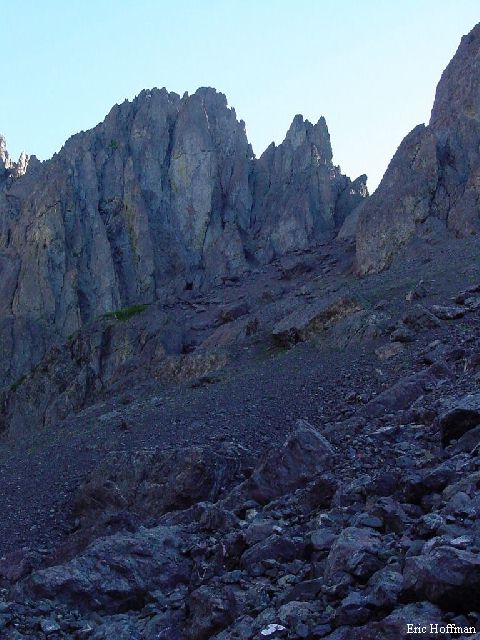The "Cat Ears" from south of the south chute

This was a return to take care of some unfinished business. See the previous report on Mt. Constance for trailhead, approach and limited route information. One thing I learned on the first trip was that it is best to begin the ascent of the south chute as soon as the "Cat Ears" are visible. This is the tower just left of the notch in the photo below. By beginning the ascent sooner, much of the unpleasant scree in the chute can be avoided and there is a path in places to make things even easier.
|
The "Cat Ears" from south of the south chute |
|
|
Four hours after leaving the trailhead I was back at the "Finger Traverse", this time equipped with a rope. Setting up a solo-belay using two of the several pitons already placed for an anchor system. I made my way across the narrowing ledge, rounded the corner and made the traverse across the slab. The finger traverse was actually relatively easy but exposed. There are good hand holds at the top of the slab but not much in the way of foot holds for the first few feet. Once across the slab, traverse the east side of the ridge and until able to descend into the snow basin below. Once in the basin, climb scree and rock on the right of cliffs to the scree slope below the summit. About a hundred feet of scrambling leads to the ridge which can then be traversed to the summit tower. The tower is climbed on the north side. The views are spectacular, adding to the rewards of this climb.
|
The summit of Mt. Constance from near the "Finger Traverse" |
|
|
|
The "Finger Traverse" from the summit of Mt. Constance |
|
|
|
Mt. Baker to Glacier Peak, Puget Sound and Hood Canal |
|
|
References:
Climber's Guide to the Olympic Mountains, third edition; Olympic Mountain
Rescue; Pages 102-106, 108
Olympic Mountains Trail Guide; Robert Wood; Pages 139, 292-293